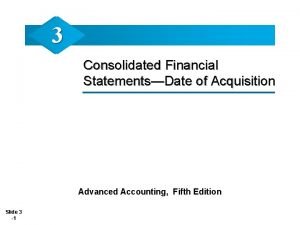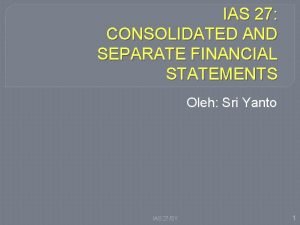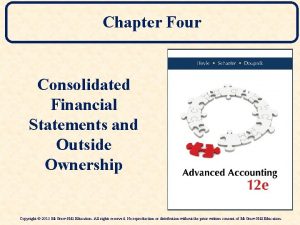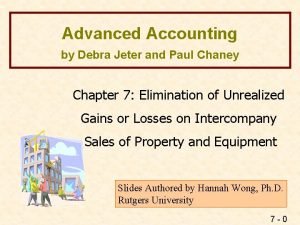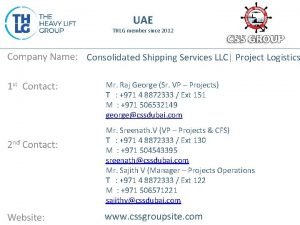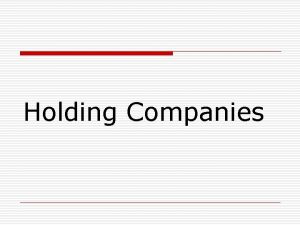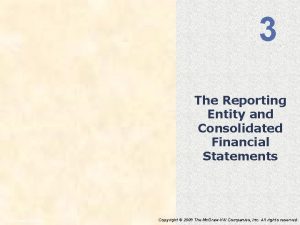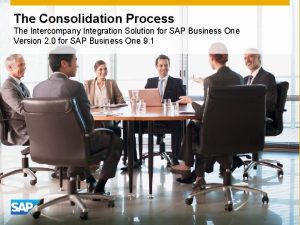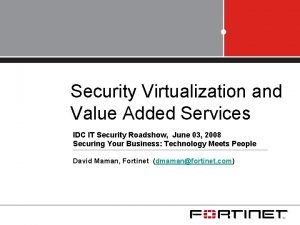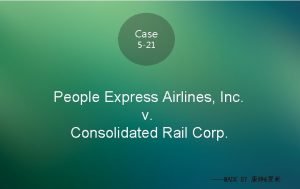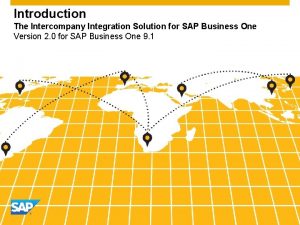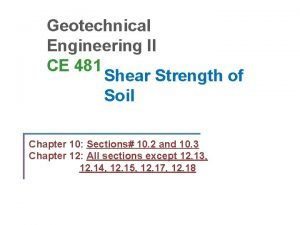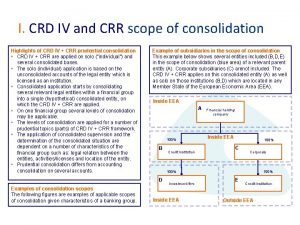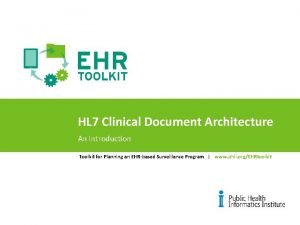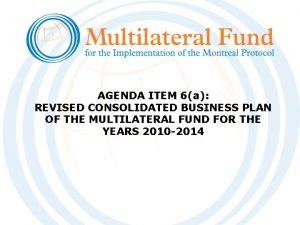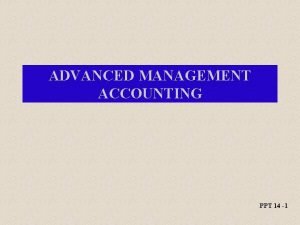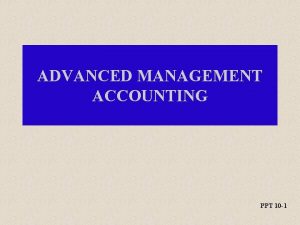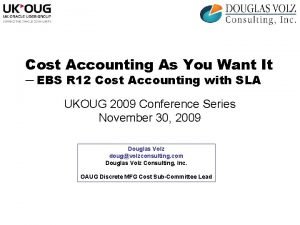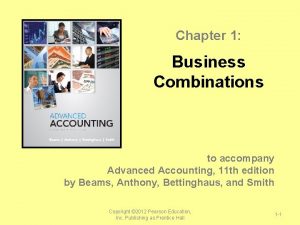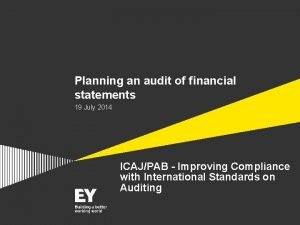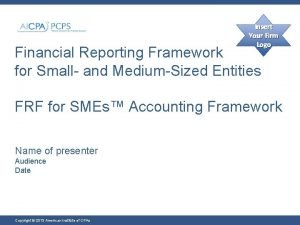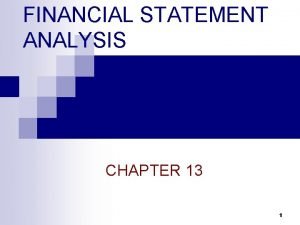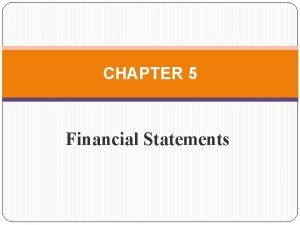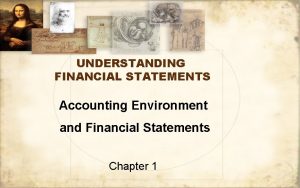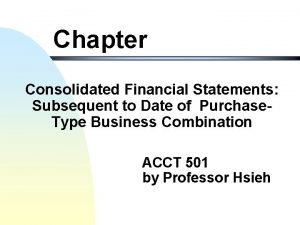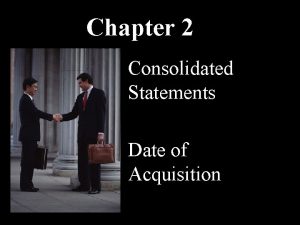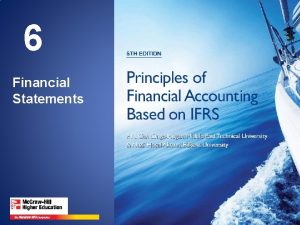Advanced Accounting Jeter Chaney Consolidated Financial Statements Date




















































- Slides: 52

Advanced Accounting Jeter ● Chaney Consolidated Financial Statements —Date of Acquisition 1 Prepared by Sheila Ammons, Austin Community College

Learning Objectives • Understand the concept of control as used in reference to consolidations. • Explain the role of a noncontrolling interest in business combinations. • Describe the reasons why a company acquires a subsidiary rather than its net assets. • Describe the valuation and classification of accounts in consolidated financial statements. • List the requirements for inclusion of a subsidiary in consolidated financial statements. 2 Copyright © 2015. John Wiley & Sons, Inc. All rights reserved.

Learning Objectives • Discuss the limitations of consolidated financial statements. • Record the investment in the subsidiary on the parent’s books at the date of acquisition. • Prepare the consolidated workpapers and eliminating entries at the date of acquisition. • Compute and allocate the difference between implied value and book value of the acquired firm’s equity. • Discuss some of the similarities and differences between U. S. GAAP and IFRS with respect to the preparation of consolidated financial statements at the date of acquisition. 3 Copyright © 2015. John Wiley & Sons, Inc. All rights reserved.

Stock Acquisitions Chapter Focus - Accounting for Stock Acquisitions • When one company controls another company through direct or indirect ownership of some or all of its voting stock. – Acquiring company referred to as the parent. – Acquired company referred to as the subsidiary. – Other shareholders considered noncontrolling interest. – Parent records interest in subsidiary as an investment. – If a subsidiary owns a controlling interest in one or more other companies, a chain of ownership is forged by which the parent company controls other companies. LO 2 Noncontrolling interest (NCI). Copyright © 2015. John Wiley & Sons, Inc. All rights reserved. 4

Definitions of Subsidiary and Control • The Securities and Exchange Commission defines a subsidiary as an affiliate controlled by another entity, directly or indirectly, through one or more intermediaries. – Control means the possession, direct or indirect, of the power to direct management and policies of another entity, whether through the ownership of voting shares, by contract, or otherwise. 5 LO 1 Meaning of control. Copyright © 2015. John Wiley & Sons, Inc. All rights reserved.

Definitions of Subsidiary and Control Subsidiary: –A parent company (and/or the parent’s other subsidiaries) owns a controlling financial interest in another company. Control: Ø Both the IASB and the FASB have indicated their opinion that the definition of control should not be limited to the common presumption in practice of a 50% cutoff but should instead include an indirect ability to control another entity’s assets. • The usual condition for a controlling financial interest is ownership of a majority voting interest. [FASB ASC paragraph 810 -10 -15 -8] 6 LO 1 Meaning of control. Copyright © 2015. John Wiley & Sons, Inc. All rights reserved.

Definitions of Subsidiary and Control (continued): • However, application of the majority voting interest requirement may not identify the party with a controlling financial interest because the controlling financial interest may be achieved through arrangements that do not involve voting interests. • The first step in determining whether the financial statements should be consolidated is to determine if the reporting entity has a variable interest in another entity, referred to as a potential variable interest entity (VIE). 7 LO 1 Meaning of control. Copyright © 2015. John Wiley & Sons, Inc. All rights reserved.

Definitions of Control 8 LO 1 Meaning of control. Copyright © 2015. John Wiley & Sons, Inc. All rights reserved.

Requirements for the Inclusion of Subsidiaries in the Consolidated Financial Statements Purpose of consolidated statements - to present the operating results and the financial position of a parent and all its subsidiaries as if they are one economic entity. Circumstances when majority-owned subsidiaries should be excluded from the consolidated statements: – Control does not rest with the majority owner. – Subsidiary operates under governmentally imposed uncertainty so severe as to raise significant doubt about the parent’s control. 9 LO 5 Requirements regarding consolidation of subsidiaries. Copyright © 2015. John Wiley & Sons, Inc. All rights reserved.

Reasons For Subsidiary Companies Advantages to acquiring a controlling interest in the voting stock of another company rather than its assets or all of its voting stock. – Stock acquisition is relatively simple. – Control of subsidiary can be accomplished with a smaller investment. – Separate legal existence of affiliates provides an element of protection of the parent’s assets. 10 LO 3 Acquiring assets or stock. Copyright © 2015. John Wiley & Sons, Inc. All rights reserved.

Consolidated Financial Statements prepared for a parent company and its subsidiaries are called consolidated financial statements. – Ignore legal aspects of separate entities, but focus instead, on economic entity under “control” of management. – Focus on substance rather than form. – Not substitutes for statements prepared by separate subsidiaries, which may be used by: • Creditors • Noncontrolling stockholders • Regulatory agencies. 11 LO 4 Valuation and classification of subsidiary assets and liabilities. Copyright © 2015. John Wiley & Sons, Inc. All rights reserved.

Consolidated Financial Statements Purpose of consolidated financial statements: – To present, primarily for the benefit of the owners and creditors of the parent, the results of operations and the financial positions of a parent company and all of its subsidiaries • As if the consolidated group were a single economic entity. 12 LO 4 Valuation and classification of subsidiary assets and liabilities. Copyright © 2015. John Wiley & Sons, Inc. All rights reserved.

Investments at the Date of Acquisition Recording Investments at Cost (Parent’s Books) • Stock investment is recorded at cost as measured by fair value of the consideration given or consideration received, whichever is more clearly evident. – Consideration given may include cash, other assets, debt securities, stock of the acquiring company, or a combination of these items. Ø Both the direct costs of acquiring the stock and the indirect costs relating to acquisitions (such as costs of maintaining an acquisitions department) should be expensed as incurred. 13 LO 7 Recording of investment at acquisition. Copyright © 2015. John Wiley & Sons, Inc. All rights reserved.

Investments at the Date of Acquisition E 3 -2: On January 1, 2014, Polo Company purchased 100% of the common stock of Save Company by issuing 40, 000 shares of its (Polo’s) $10 par value common stock with a market price of $17. 50 per share. Polo incurred cash expenses of $20, 000 for registering and issuing the common stock. The stockholders’ equity section of the two companies’ balance sheets on December 31, 2013, were: Polo Save Common stock, $10 par value $350, 000 $320, 000 Other contributed capital 590, 000 175, 000 Retained earnings 380, 000 205, 000 14 LO 7 Recording of investment at acquisition. Copyright © 2015. John Wiley & Sons, Inc. All rights reserved.

Investments at the Date of Acquisition E 3 -2: Prepare the journal entry on the books of Polo Company to record the purchase of the common stock of Save Company and related expenses. Investment in Save (40, 000 x $17. 50) Common Stock 700, 000 400, 000 Other Contributed Capital 300, 000 Other Contributed Capital 20, 000 Cash 20, 000 Stock registration and issuance costs reduce Other Contributed Capital 15 LO 7 Recording of investment at acquisition. Copyright © 2015. John Wiley & Sons, Inc. All rights reserved.

Consolidated Balance Sheets: Use of Workpapers Assets and liabilities are summed in their entirety, regardless of whether the parent owns 100% or a smaller controlling interest. – Noncontrolling interests (NCI) are reflected as a component of owners’ equity. – Eliminations must be made to cancel the effects of transactions among the parent and its subsidiaries. – A workpaper is frequently used to summarize the effects of various additions and eliminations. 16 LO 8 Preparing consolidated statements using a workpaper. Copyright © 2015. John Wiley & Sons, Inc. All rights reserved.

Consolidated Balance Sheets: Use of Workpapers Intercompany Accounts to Be Eliminated Parent’s Accounts Subsidiary’s Accounts Investment in subsidiary Against Equity accounts Intercompany receivable (payable) Against Intercompany payable (receivable) Advances to subsidiary (from subsidiary) Against Advances from parent (to parent) Interest revenue (interest expense) Against Interest expense (interest revenue) Dividend revenue (dividends declared) Against Dividends declared (dividend revenue) Management fee received from subsidiary Against Management fee paid to parent Sales to subsidiary (purchases of inventory from subsidiary) Against Purchases of inventory from parent (sales to parent) 17 LO 8 Preparing consolidated statements using a workpaper. Copyright © 2015. John Wiley & Sons, Inc. All rights reserved.

Consolidated Balance Sheets: Use of Workpapers Investment Elimination • It is necessary to eliminate the investment account of the parent company against the related stockholders’ equity of the subsidiary to avoid double counting of these net assets. • When parent’s share of subsidiary’s equity is eliminated against the investment account, subsidiary’s net assets are substituted for the investment account in the consolidated balance sheet. 18 LO 8 Investment is eliminated for consolidated statements. Copyright © 2015. John Wiley & Sons, Inc. All rights reserved.

Consolidated Balance Sheets: Use of Workpapers Investment Elimination • Computation and Allocation of Difference between Implied Value and Book Value (CAD) – Step 1: Determine percentage of stock acquired. – Step 2: Divide purchase price by the percentage acquired* to calculate the implied value of the subsidiary. * If 100%, the implied value will equal the purchase price. – Step 3: Difference between Step 2 and book value of subsidiary’s equity must be allocated to adjust the underlying assets and/or liabilities of the acquired company. LO 9 Computing and allocating the difference between 19 implied and book value (CAD). Copyright © 2015. John Wiley & Sons, Inc. All rights reserved.

Consolidated Balance Sheets: Use of Workpapers The prior steps lead to the following possible cases: Case 1. The implied value (IV) of the subsidiary is equal to the book value of the subsidiary’s equity (IV = BV), and a. The parent company acquires 100% of the subsidiary’s stock; or b. The parent company acquires less than 100% of the subsidiary’s stock. Case 2. The implied value of the subsidiary exceeds the book value of the subsidiary’s equity (IV > BV), and a. The parent company acquires 100% of the subsidiary’s stock; or b. The parent company acquires less than 100% of the subsidiary’s stock. Case 3. The implied value of the subsidiary is less than the book value of the subsidiary’s equity (IV < BV), and a. The parent company acquires 100% of the subsidiary’s stock; or b. The parent company acquires less than 100% of the subsidiary’s stock. LO 9 Computing and allocating the difference between 20 implied and book value (CAD). Copyright © 2015. John Wiley & Sons, Inc. All rights reserved.

Consolidated Balance Sheets: Use of Workpapers Case 1(a): Implied Value of Subsidiary Is Equal to Book Value of Subsidiary Company’s Equity (IV = BV) - 100% of Stock Acquired. Illustration: Assume that on January 1, 2015, P Company acquired all the outstanding stock (10, 000 shares) of S Company for cash of $160, 000. What journal entry would P Company make to record the shares of S Company acquired? Investment in S Company Cash $160, 000 LO 9 Computing and allocating the difference between 21 implied and book value (CAD). Copyright © 2015. John Wiley & Sons, Inc. All rights reserved.

Consolidated Balance Sheets: Use of Workpapers Case 1(a): The balance sheets of both companies immediately after the acquisition of shares is as follows: Implied value = Book value Price paid $160, 000 % acquired 100% Implied value 160, 000 Book value 160, 000 Difference $0 LO 9 Computing and allocating the difference between 22 implied and book value (CAD). Copyright © 2015. John Wiley & Sons, Inc. All rights reserved.

Consolidated Balance Sheets: Use of Workpapers Case 1(a): The workpaper to consolidate the balance sheets for P and S on Jan. 1, 2015, date of acquisition, is presented below: Adjusting and eliminating entries are made on the workpaper for the preparation of consolidated statements. LO 9 Computing and allocating the difference between implied and book value (CAD). 23 Copyright © 2015. John Wiley & Sons, Inc. All rights reserved.

Consolidated Balance Sheets: Use of Workpapers Case 1(a): The workpaper to consolidate the balance sheets for P and S on Jan. 1, 2015, date of acquisition, is presented below: LO 9 Computing and allocating the difference between implied and book value (CAD). 24 Copyright © 2015. John Wiley & Sons, Inc. All rights reserved.

Consolidated Balance Sheets: Use of Workpapers Case 1(a): The workpaper entry to eliminate S Company’s stockholders’ equity against the investment account is: Common Stock (S) 100, 000 Other Contributed Capital (S) 20, 000 Retained Earnings (S) 40, 000 Investment in S Company 160, 000 This is a workpaper-only entry. LO 9 Computing and allocating the difference between implied and book value (CAD). 25 Copyright © 2015. John Wiley & Sons, Inc. All rights reserved.

Consolidated Balance Sheets: Use of Workpapers Case 1(a): Note the following on the workpaper. • Investment account and related subsidiary’s stockholders’ equity have been eliminated. • Subsidiary’s net assets have been substituted for the investment account. • Consolidated assets and liabilities consist of the sum of the parent and subsidiary assets and liabilities in each classification. • Consolidated stockholders’ equity is the same as the parent company’s stockholders’ equity. • Consolidated balance sheet is that of the economic entity. LO 9 Computing and allocating the difference between implied and book value (CAD). 26 Copyright © 2015. John Wiley & Sons, Inc. All rights reserved.

Consolidated Balance Sheets: Use of Workpapers Case 1(b): Parent’s Cost of Investment Is Equal to Book Value of Subsidiary’s Stock Acquired (IV=BV) - Partial Ownership. Illustration: Assume that on January 1, 2015, P Company acquired 90% (9, 000 shares) of the stock of S Company for $144, 000. What journal entry would P Company make to record the shares of S Company acquired? Investment in S Company Cash $144, 000 LO 9 Computing and allocating the difference between implied and book value (CAD). 27 Copyright © 2015. John Wiley & Sons, Inc. All rights reserved.

Consolidated Balance Sheets: Use of Workpapers Case 1(b): The balance sheets of both companies immediately after the acquisition of shares is as follows: Implied value = Book value Price paid $144, 000 % acquired 90% Implied value 160, 000 Book value 160, 000 Difference $0 LO 9 Computing and allocating the difference between implied and book value (CAD). 28 Copyright © 2015. John Wiley & Sons, Inc. All rights reserved.

Consolidated Balance Sheets: Use of Workpapers Case 1(b): Computation and Allocation of Difference between Implied and Book Values: LO 9 Computing and allocating the difference between implied and book value (CAD). 29 Copyright © 2015. John Wiley & Sons, Inc. All rights reserved.

Consolidated Balance Sheets: Use of Workpapers Case 1(b): The workpaper to consolidate the balance sheets for P and S on Jan. 1, 2015, date of acquisition, is presented below: Solution on notes page LO 9 Computing and allocating the difference between 30 implied and book value (CAD). Copyright © 2015. John Wiley & Sons, Inc. All rights reserved.

Consolidated Balance Sheets: Use of Workpapers Case 1(b): The workpaper to consolidate the balance sheets for P and S on Jan. 1, 2015, date of acquisition, is presented below: LO 9 Computing and allocating the difference between implied and book value (CAD). 31 Copyright © 2015. John Wiley & Sons, Inc. All rights reserved.

Consolidated Balance Sheets: Use of Workpapers Case 1(b): The workpaper entry to eliminate S Company’s stockholders’ equity against the investment account is: Common Stock (S) 100, 000 Other Contributed Capital (S) 20, 000 Retained Earnings (S) 40, 000 Investment in S Company 144, 000 Noncontrolling Interest in Equity 16, 000 (establish the NCI) LO 9 Computing and allocating the difference between implied and book value (CAD). 32 Copyright © 2015. John Wiley & Sons, Inc. All rights reserved.

Consolidated Balance Sheets: Use of Workpapers Case 2(b): Implied Value Exceeds Book Value of Subsidiary Company’s Equity (IV>BV) - Partial Ownership. Illustration: Assume that on January 1, 2015, P Company acquired 80% (8, 000 shares) of the stock of S Company for $148, 000. What journal entry would P Company make to record the shares of S Company acquired? Investment in S Company Cash $148, 000 LO 9 Computing and allocating the difference between implied and book value (CAD). 33 Copyright © 2015. John Wiley & Sons, Inc. All rights reserved.

Consolidated Balance Sheets: Use of Workpapers Case 2(b): The balance sheets of both companies immediately after the acquisition of shares is as follows: Implied value = Book value Price paid $148, 000 % acquired 80% Implied value 185, 000 Book value 160, 000 Difference $25, 000 LO 9 Computing and allocating the difference between implied and book value (CAD). 34 Copyright © 2015. John Wiley & Sons, Inc. All rights reserved.

Consolidated Balance Sheets: Use of Workpapers Case 2(b): Computation and Allocation of Difference between Implied and Book Values: We assume the entire difference is attributable to land with a current value higher than historical cost. LO 9 Computing and allocating the difference between implied and book value (CAD). 35 Copyright © 2015. John Wiley & Sons, Inc. All rights reserved.

Consolidated Balance Sheets: Use of Workpapers Case 2(b): The workpaper to consolidate the balance sheets for P and S on Jan. 1, 2015, date of acquisition, is presented below: LO 9 Computing and allocating the difference between implied and book value (CAD). 36 Copyright © 2015. John Wiley & Sons, Inc. All rights reserved.

Consolidated Balance Sheets: Use of Workpapers Case 2(b): The workpaper (elimination) entries are as follows: #1 Common Stock (S) 100, 000 Other Contributed Capital (S) 20, 000 Retained Earnings (S) 40, 000 Difference between IV and BV 25, 000 Investment in S Company 148, 000 Noncontrolling Interest in Equity #2 Land 37, 000 25, 000 Difference between IV and BV 25, 000 LO 9 Computing and allocating the difference between implied and book value (CAD). 37 Copyright © 2015. John Wiley & Sons, Inc. All rights reserved.

Consolidated Balance Sheets: Use of Workpapers Case 2(b) Reasons an Acquiring Company May Pay More Than Book Value: 1) Fair value of specific tangible or intangible assets of the subsidiary may exceed the recorded value because of appreciation. 2) Excess payment may indicate existence of goodwill. 3) Liabilities, generally long-term, may be overvalued. 4) A variety of market factors may affect the price paid. LO 9 Computing and allocating the difference between implied and book value (CAD). 38 Copyright © 2015. John Wiley & Sons, Inc. All rights reserved.

Consolidated Balance Sheets: Use of Workpapers Case 3(b): Implied Value of Subsidiary is Less Than Book Value (IV<BV) - Partial Ownership. Illustration: Assume that on January 1, 2015, P Company acquired 80% (8, 000 shares) of the stock of S Company for $120, 000. What journal entry would P Company make to record the shares of S Company acquired? Investment in S Company Cash $120, 000 LO 9 Computing and allocating the difference between implied and book value (CAD). 39 Copyright © 2015. John Wiley & Sons, Inc. All rights reserved.

Consolidated Balance Sheets: Use of Workpapers Case 3(b): The balance sheets of both companies immediately after the acquisition of shares is as follows: Implied value = Book value Price paid $120, 000 % acquired 80% Implied value 150, 000 Book value 160, 000 Difference $10, 000 LO 9 Computing and allocating the difference between implied and book value (CAD). 40 Copyright © 2015. John Wiley & Sons, Inc. All rights reserved.

Consolidated Balance Sheets: Use of Workpapers Case 3(b): Computation and Allocation of Difference between Implied and Book Values: Assume the difference is attributable to plant and equipment, in this case an overvaluation of $10, 000. LO 9 Computing and allocating the difference between implied and book value (CAD). 41 Copyright © 2015. John Wiley & Sons, Inc. All rights reserved.

Consolidated Balance Sheets: Use of Workpapers Case 3(b): The workpaper to consolidate the balance sheets for P and S on Jan. 1, 2015, date of acquisition, is presented below: LO 9 Computing and allocating the difference between implied and book value (CAD). 42 Copyright © 2015. John Wiley & Sons, Inc. All rights reserved.

Consolidated Balance Sheets: Use of Workpapers Case 3(b): The workpaper (elimination) entries are as follows: #1 Common Stock (S) 100, 000 Other Contributed Capital (S) 20, 000 Retained Earnings (S) 40, 000 Difference between IV and BV Investment in S Company 10, 000 120, 000 Noncontrolling Interest in Equity #2 30, 000 Difference between IV and BV 10, 000 Plant and Equipment 10, 000 LO 9 Computing and allocating the difference between implied and book value (CAD). 43 Copyright © 2015. John Wiley & Sons, Inc. All rights reserved.

Consolidated Balance Sheets: Use of Workpapers Review Question The noncontrolling interest in the subsidiary is reported as: a) Asset b) Liability c) Equity d) Expense LO 9 Computing and allocating the difference between implied and book value (CAD). Copyright © 2015. John Wiley & Sons, Inc. All rights reserved. 44

Consolidated Balance Sheets: Use of Workpapers Subsidiary Treasury Stock Holdings • A subsidiary may hold some of its own shares as treasury stock at the time the parent company acquires its interest. • Because the treasury stock account represents a contra stockholders’ equity account, it must be eliminated by a credit when the investment account and subsidiary company’s equity accounts are eliminated on the workpaper. LO 9 Computing and allocating the difference between implied and book value (CAD). 45 Copyright © 2015. John Wiley & Sons, Inc. All rights reserved.

Consolidated Balance Sheets: Use of Workpapers Other Intercompany Balance Sheet Eliminations • Intercompany accounts receivable, notes receivable, and interest receivable, for example, must be eliminated against the reciprocal accounts payable, notes payable, and interest payable. • Eliminations must also be made for all types of intercompany accruals for such items as rent and other services. • The full amount of all intercompany receivables and payables is eliminated without regard to the percentage of control held by the parent company. LO 9 Computing and allocating the difference between implied and book value (CAD). 46 Copyright © 2015. John Wiley & Sons, Inc. All rights reserved.

Consolidated Balance Sheets: Use of Workpapers Adjusting Entries Prior to Eliminating Entries • At times, workpaper adjustments to accounting data may be needed before appropriate eliminating entries can be accomplished. The need for adjustments generally arises because of in-transit items when only one of the affiliates has recorded the effect of an intercompany transaction. – Enter these adjusting entries on worksheet eliminations columns or – Adjust the subsidiary’s statements prior to their entry on the workpaper. LO 9 Computing and allocating the difference between implied and book value (CAD). 47 Copyright © 2015. John Wiley & Sons, Inc. All rights reserved.

Consolidated Balance Sheets: Use of Workpapers Review Question Which of the following adjustments do not occur in the consolidating process? a) Elimination of parent’s retained earnings b) Elimination of intra-company balances c) Allocations of difference between implied and book values d) Elimination of the investment account LO 9 Computing and allocating the difference between implied and book value (CAD). 48 Copyright © 2015. John Wiley & Sons, Inc. All rights reserved.

Limitations of Consolidated Statements Consolidated statements may have limited usefulness for noncontrolling stockholders, subsidiary creditors, and some regulatory agencies. For Example: – Little information of value in consolidated statements because they contain insufficient detail about the individual subsidiaries. – Highly diversified companies operating across several industries, often the result of mergers and acquisitions, are difficult to analyze or compare. 49 LO 6 Limitations of consolidated statements. Copyright © 2015. John Wiley & Sons, Inc. All rights reserved.

IFRS Versus U. S. GAAP LO 10 Similarities and differences between U. S. GAAP and IFRS. 50 Copyright © 2015. John Wiley & Sons, Inc. All rights reserved.

IFRS Versus U. S. GAAP LO 10 Similarities and differences between U. S. GAAP and IFRS. 51 Copyright © 2015. John Wiley & Sons, Inc. All rights reserved.

IFRS Versus U. S. GAAP LO 10 Similarities and differences between U. S. GAAP and IFRS. 52 Copyright © 2015. John Wiley & Sons, Inc. All rights reserved.
 Consolidated financial statements date of acquisition
Consolidated financial statements date of acquisition Terzaghi's bearing capacity theory
Terzaghi's bearing capacity theory Ias 27
Ias 27 Consolidated financial statements and outside ownership
Consolidated financial statements and outside ownership Dr sharon chaney
Dr sharon chaney Alain chaney
Alain chaney Chaney et al
Chaney et al Chaney padre e hijo crucigrama
Chaney padre e hijo crucigrama Unit 13 accounting and financial statements
Unit 13 accounting and financial statements Intermediate accounting chapter 1
Intermediate accounting chapter 1 Cost and management accounting ppt
Cost and management accounting ppt Where was jeter born
Where was jeter born Debra jeter
Debra jeter Epauler jeter
Epauler jeter Derek jeter diet
Derek jeter diet Jetra anatomija
Jetra anatomija Record date ex dividend date
Record date ex dividend date Eligibility for dividend
Eligibility for dividend Consolidated shipping services
Consolidated shipping services Consolidated global group
Consolidated global group What is subsidiary and holding company
What is subsidiary and holding company Essa consolidated application
Essa consolidated application Advantages and disadvantages of vane shear test
Advantages and disadvantages of vane shear test Incomparent
Incomparent Consolidated companies are different sap
Consolidated companies are different sap Noc saga consolidated
Noc saga consolidated Consolidated service center
Consolidated service center People express airlines v consolidated rail corp
People express airlines v consolidated rail corp Abitibi consolidated
Abitibi consolidated My mchcp
My mchcp Intercompany integration solution for sap business one
Intercompany integration solution for sap business one Business intelligence project plan
Business intelligence project plan Equity accounted investments
Equity accounted investments Consolidated
Consolidated Sap b1 transaction notification
Sap b1 transaction notification Unconsolidated undrained triaxial test mohr circle
Unconsolidated undrained triaxial test mohr circle Consolidated monitoring
Consolidated monitoring Crd iv and crr difference
Crd iv and crr difference Clinical document architecture
Clinical document architecture Aquifer
Aquifer Consolidated trust
Consolidated trust Calaveras consolidated fire
Calaveras consolidated fire Consolidated business plan
Consolidated business plan Introduction to managerial accounting ppt
Introduction to managerial accounting ppt Role of management accounting ppt
Role of management accounting ppt Oracle advanced cost accounting
Oracle advanced cost accounting Advanced accounting chapter 1
Advanced accounting chapter 1 Purpose of financial report
Purpose of financial report Benefits of audit planning isa 300
Benefits of audit planning isa 300 Sample notes to financial statements for small entities
Sample notes to financial statements for small entities Analysis of financial statements
Analysis of financial statements Translate financial statements
Translate financial statements What are the 5 types of financial statements?
What are the 5 types of financial statements?
